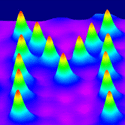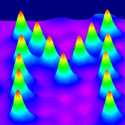Molecules shake into place
The ability to move single molecules around a surface with the tip of a scanning tunneling microscope (STM) has been around for many years. However, conventional techniques, which use direct interactions between the tip and the molecules or large electric fields, often damage the molecule.
In 2002, scientists found a less intrusive technique to control molecules [1]. By first exciting the internal vibrational energy of a molecule with an STM tip, they were able to convert this energy into rotational or translational motion of the molecule along a surface. Writing in Physical Review B, Michiaki Ohara, Yousoo Kim, and Maki Kawai from RIKEN, Saitama, and University of Tokyo, Kashiwa, Japan, demonstrate significantly more precise control over the motion of individual molecules with this technique.
The group places an STM tip off-center of a molecule on a surface. With a voltage between the tip and the copper surface of about 85 meV or higher, they excite the vibrational degree of freedom corresponding to stretching the C–S bond. The vibrating molecule is like an oscillating electric dipole that the electric field from the STM can push towards or away from the tip, depending on the polarity of the tip voltage. Ohara et al. are able to use electric fields that are an order of magnitude lower than previous methods, essentially eliminating the risk of breaking the STM tips or of molecular disassociation.
This technique is likely to have application in fields such as surface chemistry, where one could potentially manipulate chemical reactions on the single-molecule level. – Ashot Melikyan
[1] T. Komeda, Y. Kim, M. Kawai, B. N. J. Persson, and H. Ueba, Science 295, 2055 (2002).





